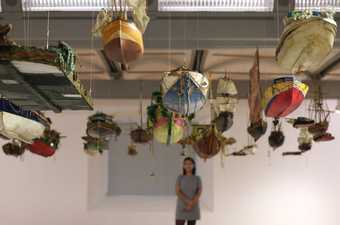
© Gareth Jones
Journeys through the Tate Collection
Explore more than 80 works from the Tate collection for free
This display of art from the Tate collection considers the impact of the global movement of people on artists and art movements throughout the twentieth century and beyond. On display are works that explore themes of migration, colonialism, and international exchange, and how they are relevant to the history of Liverpool.
Visitors can expect to see works by artists including Anish Kapoor, Sonia Boyce, Chen Zhen, Njideka Akunyili Crosby and György Kepes.
Highlights include Hew Locke’s Armada 2019, a large-scale flotilla of boats and rafts suspended from the ceiling. The sailing vessels hold complex and multiple meetings, symbolic of colonial and post-colonial power as well as the artist’s own movement to and from Guyana as a child. Also on display is Mona Hatoum’s Measures of Distance 1988 which speaks of exile, disorientation, and a tremendous sense of loss the artist experienced as a result of separation caused by the war in Lebanon.
By exploring works like these, and how they resonate with local and global history, we can consider the relationship between Liverpool and the world that it looks out on.
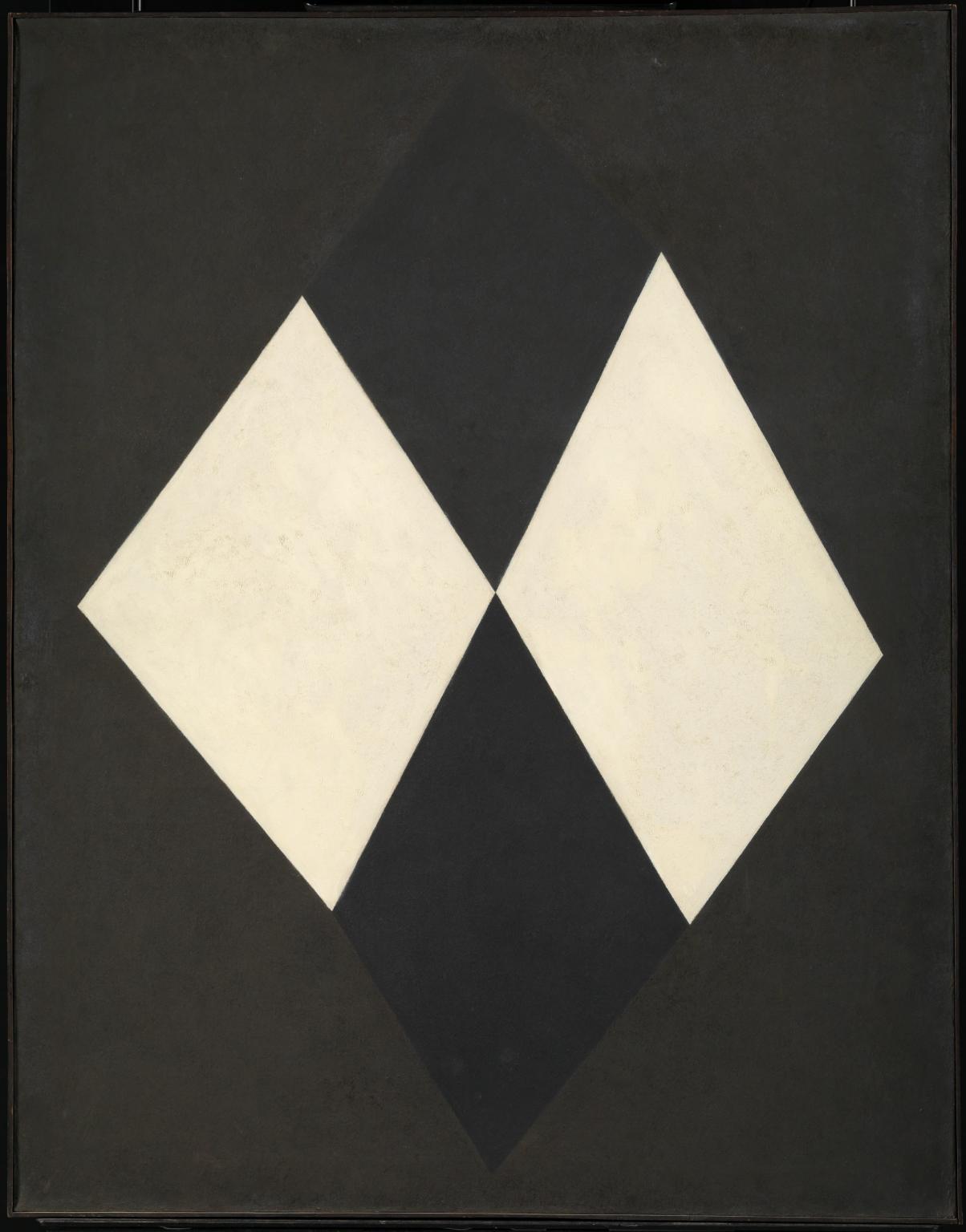
Mira Schendel, Untitled 1963
In this work, geometric figures in subdued colours are suspended in a dark, abstract background. The subtle use of texture and treatment of the surface adds a three-dimensional aspect to the painting. The forms are deliberately asymmetrical and hand-drawn, exemplifying the subtle subversion of European geometric abstraction in Brazilian art through the introduction of organic or destabilising elements. Schendel contributed to the development of Concrete and Neo-concrete art in Brazil during the 1960s, though she remained detached from those groups and developed a distinct and unique body of work.
Gallery label, May 2012
1/30
artworks in Journeys through the Tate Collection
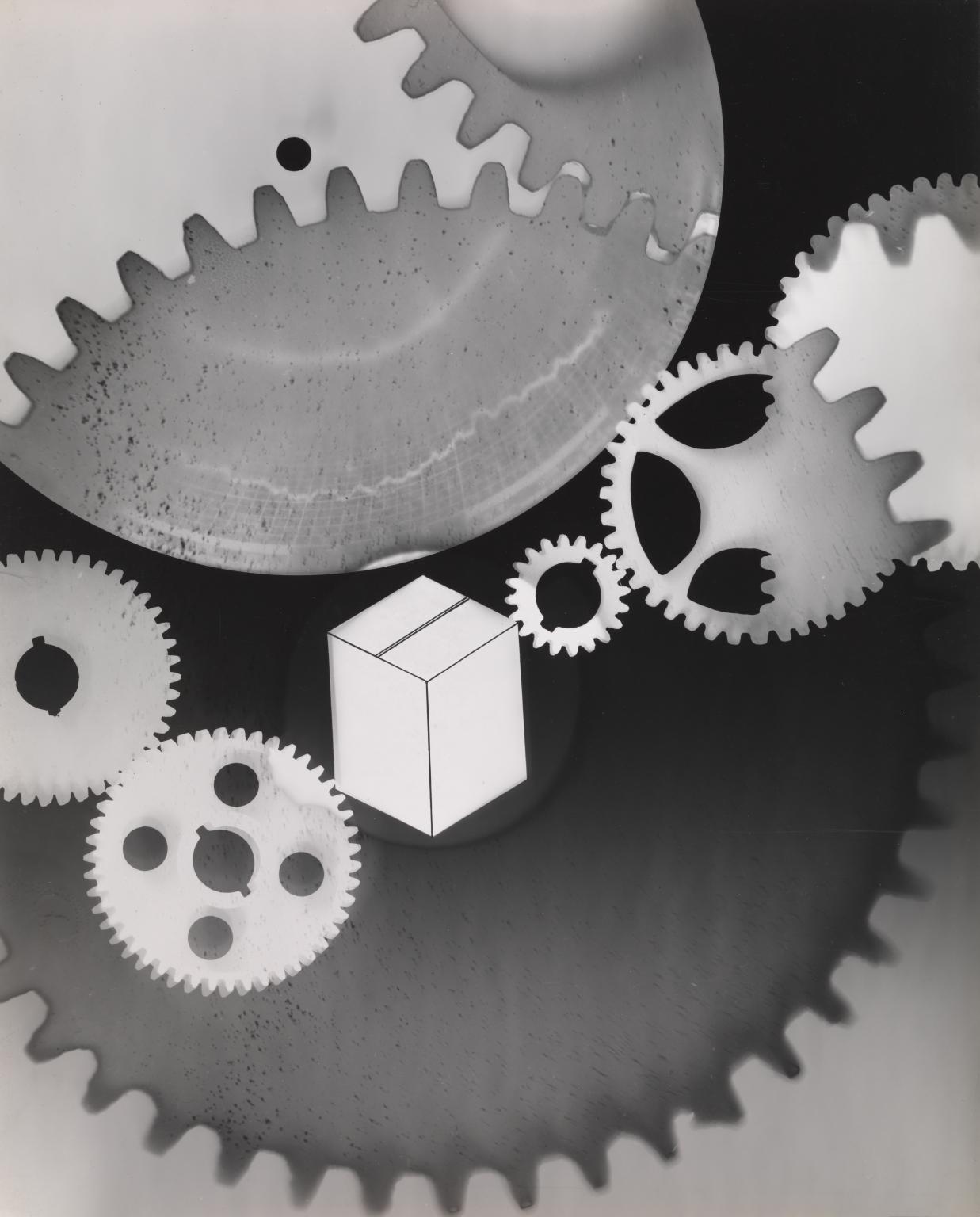
György Kepes, Gears 2 (Gears and Inked Carton) 1939–40
This is one of a large group of photograms and studies in modernist photography in Tate’s collection by the Hungarian-born photographer, painter, designer, teacher and writer, Gyorgy Kepes (see Tate P80532–P80568, T13973–T13975). They date from 1938 to the early 1940s and were made in the United States, where Kepes had emigrated in 1937. Kepes made his earliest photograms in Budapest, taking nature as his starting point, directly recording the process without a camera onto photosensitized surfaces. In the late 1920s Kepes joined the Berlin studio of the Hungarian artist and modernist photographer László Moholy-Nagy (1895–1946). Moholy-Nagy had been a teacher at the Bauhaus School in Germany and was one of the principals in promoting the values of the Bauhaus movement, as well as a pioneer who experimented with a multitude of materials and techniques. Kepes was introduced to the ‘new vision’ provided by the possibilities of modern art techniques while collaborating alongside Moholy-Nagy. He began to experiment with photograms himself – photographic prints made in the darkroom by placing objects directly onto light sensitive paper and exposing the paper to light. Later, he made prints he called ‘photo-drawings’, in which he applied paint to a glass plate that he then used as though it were a negative. Only a few of Kepes’s works from this earlier period survived the artist’s many moves in the 1930s and the Second World War.
2/30
artworks in Journeys through the Tate Collection
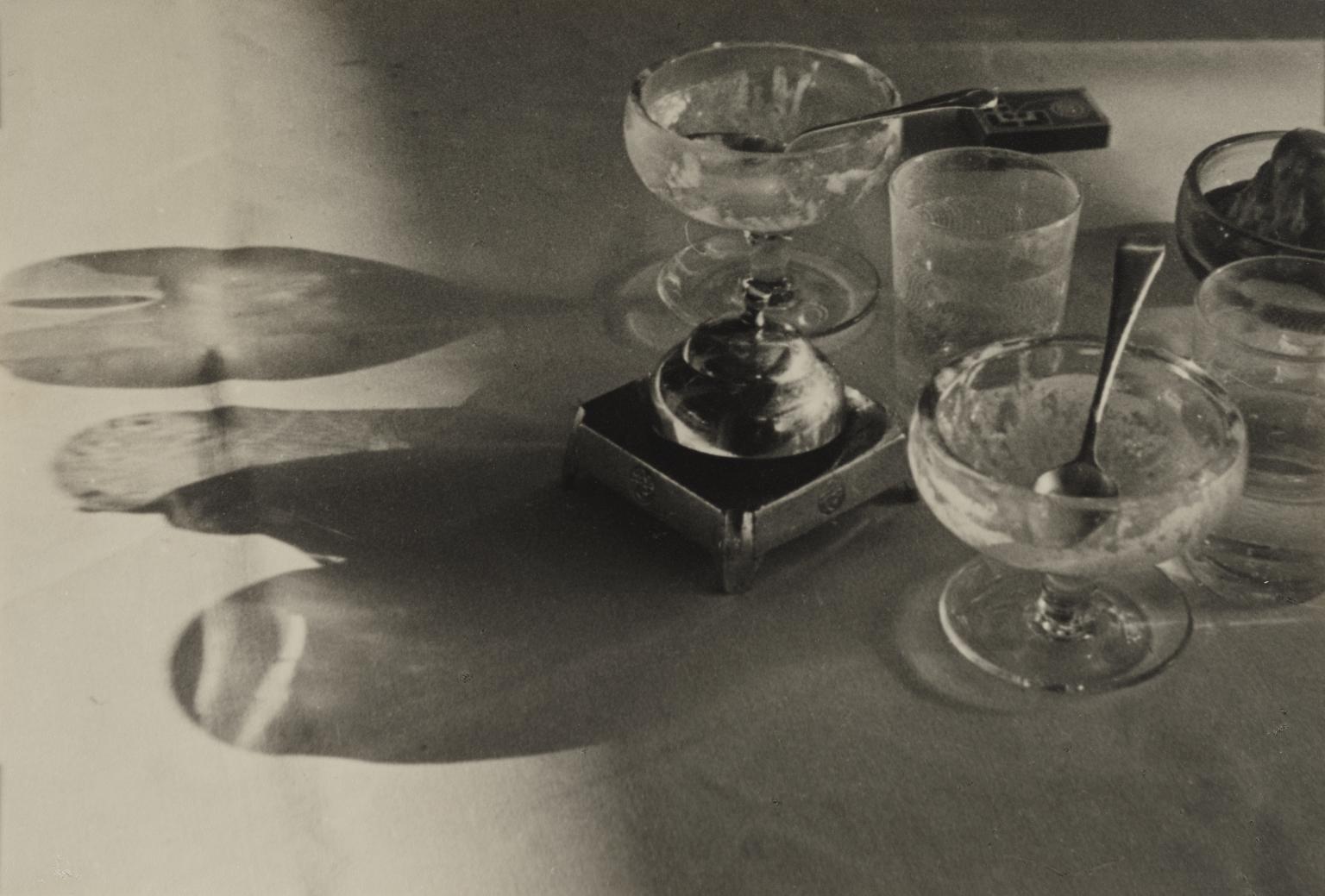
Shikanosuke Yagaki, Still Life 1930–9
Shikanosuke Yagaki was an active member of many of the amateur photography clubs flourishing in Japan in the 1930s, including the Sanwa Bank Photo Club, the Karashishi-kai Photo Group, and the Kyoto Leica Club and his work was widely exhibited. Despite a lack of professional training, Yagaki developed a sophisticated style which combined the influence of European modernism with typical Japanese subjects. His work shows a great understanding of the camera’s potential, playing with movement, perspective, light and shadow.
Gallery label, October 2016
3/30
artworks in Journeys through the Tate Collection
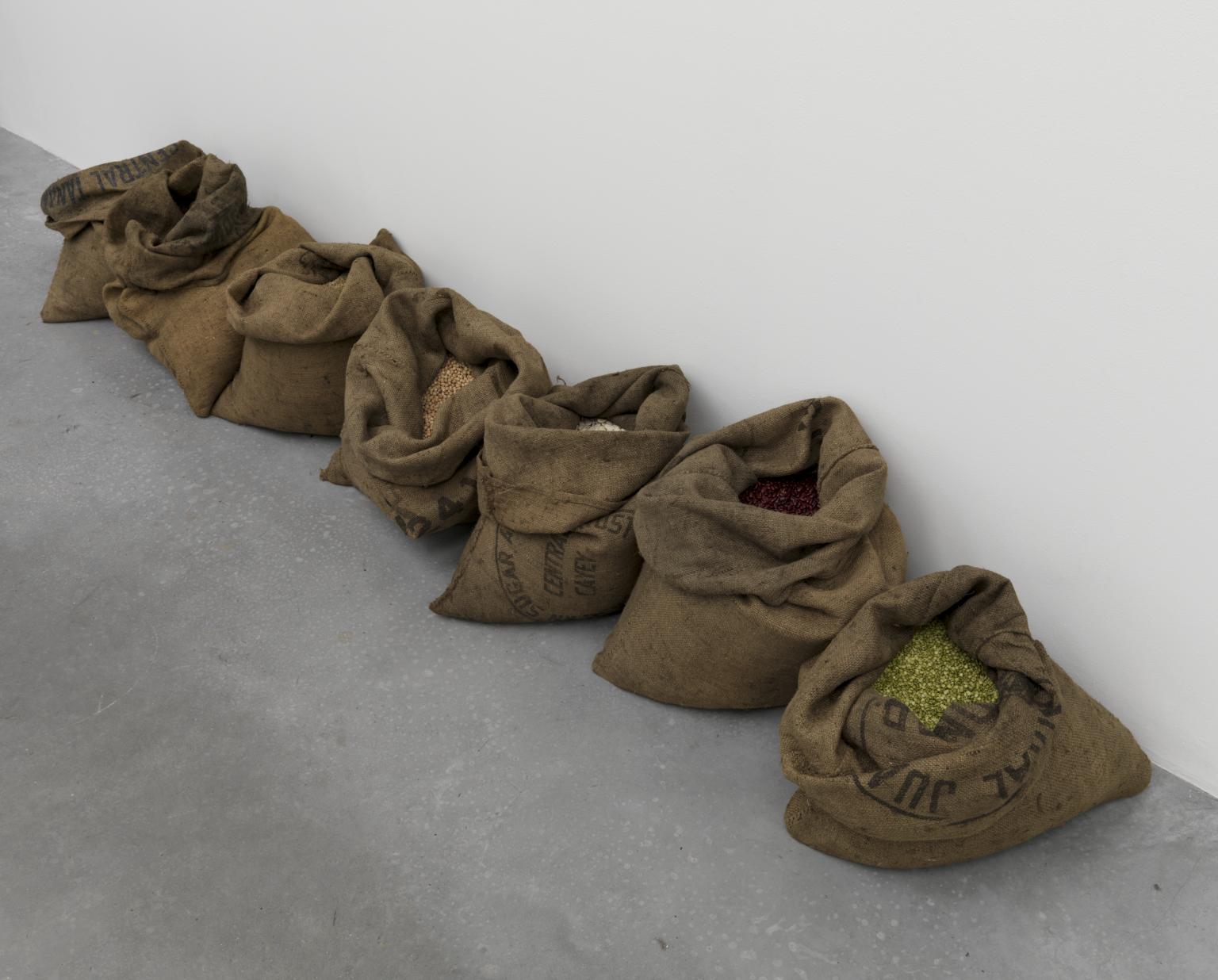
Jannis Kounellis, Untitled 1969
Untitled 1969 consists of seven burlap sacks lined up in an uneven row on the floor, against the wall. Each sack is filled with a different dried pulse or bean: chickpeas, coffee beans, green lentils, green peas, kidney beans, white beans and maize. The top of each sack is rolled back so that the contents can be seen. The sacks slump this way and that, some leaning against each other, some against the wall and some away from it.
4/30
artworks in Journeys through the Tate Collection
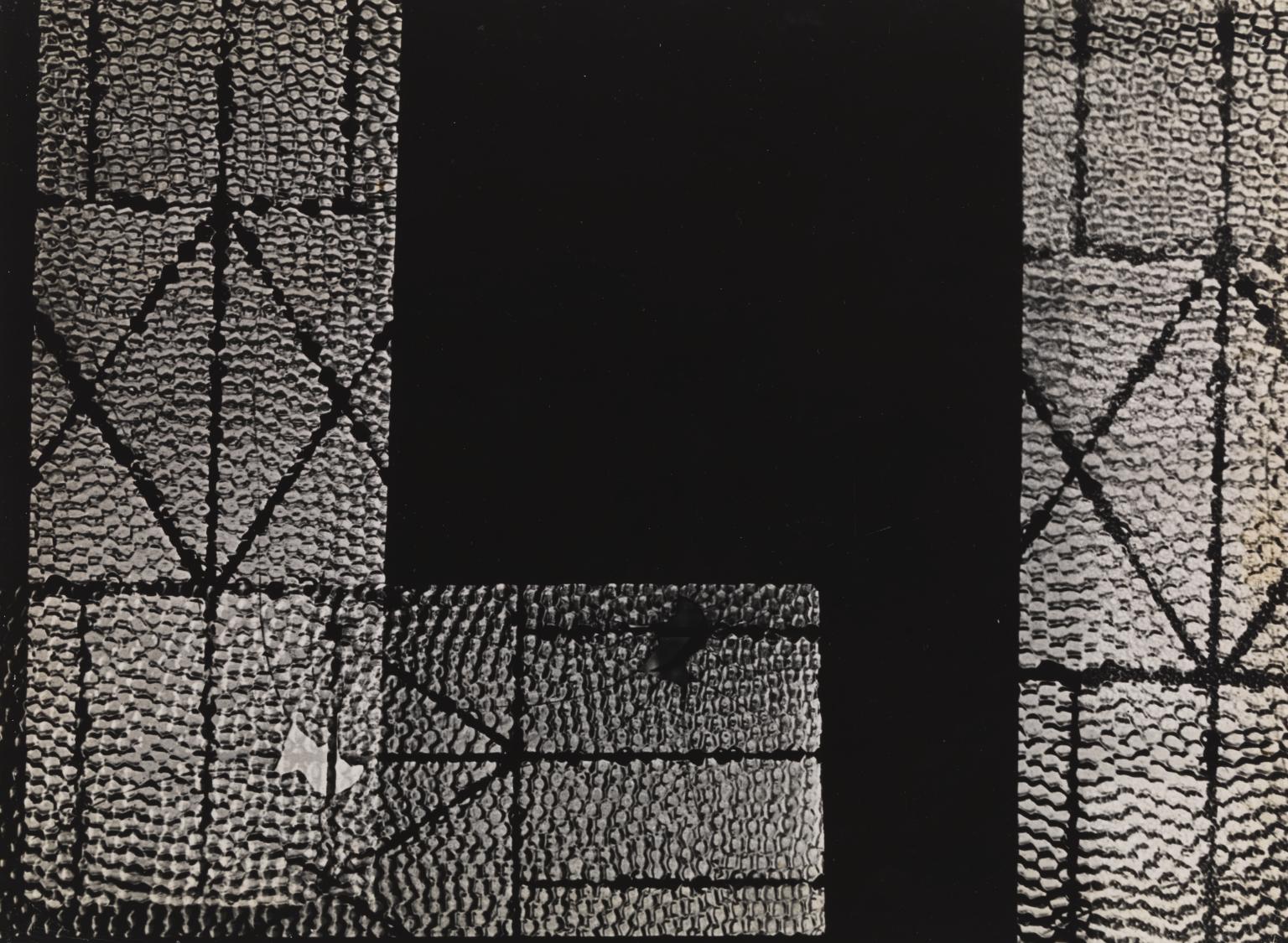
Geraldo de Barros, Abstraction (São Paulo) 1949
Abstraction (São Paulo) 1949 is a black and white vintage print by the Brazilian artist Geraldo de Barros. The photograph was taken in São Paulo and belongs to de Barros’s series of Fotoformas (or ‘photoforms’), in which the artist created abstract compositions out of photographs of architectural features. The starting point for this work was the textured glass and iron framework of a window, which was then altered using cropping and montage techniques. A related work from the same year is Untitled (São Paulo) Composition II 1949 (Tate P14601), for which de Barros photographed an elaborate iron chair through a pane of textured glass. Abstraction (São Paulo) shows de Barros’s experimentation with both the formal and technical aspects of photography. Its subject matter brings together urban architecture and formal abstraction.
5/30
artworks in Journeys through the Tate Collection
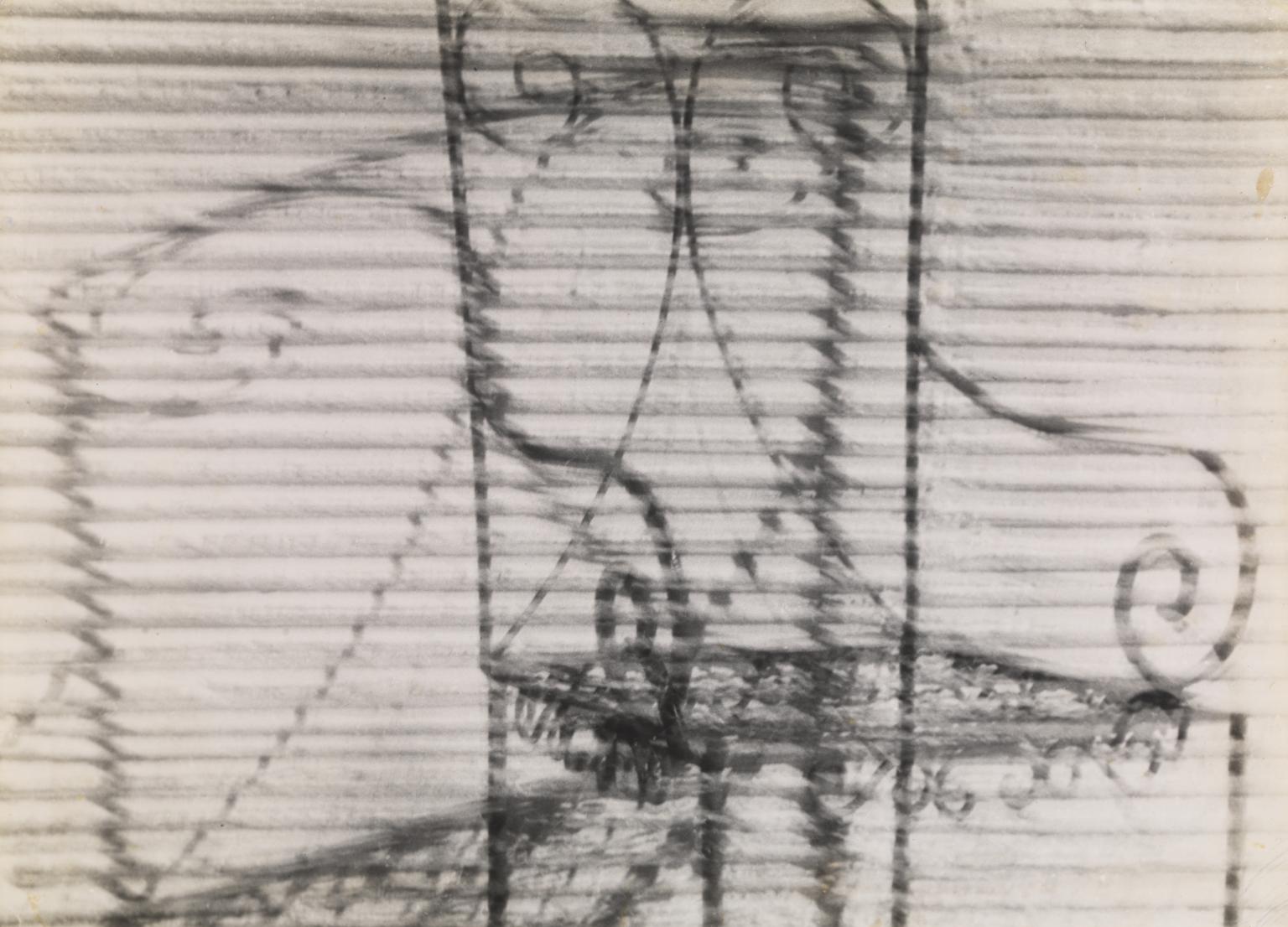
Geraldo de Barros, Untitled (São Paulo) Composition II 1949
Untitled (São Paulo) Composition II 1949 is a black and white vintage print by the Brazilian artist Geraldo de Barros. It was taken in São Paulo at a time when de Barros was creating abstract compositions out of photographs of architectural features. In this work he photographed an elaborate iron chair through a pane of textured glass. The glass distorts the image of the chair and its raking shadow, and casts a veil of horizontal lines across the composition. A related work from the same year is Abstraction (São Paulo) (Tate P14600), in which the textured glass and iron framework of a window provides the basis for the composition. This second work is from the series Fotoformas (‘photoforms’). Untitled (São Paulo) Composition II shows de Barros’s experimentation with both the formal and technical aspects of photography. Its subject brings together domestic architecture and abstraction.
6/30
artworks in Journeys through the Tate Collection
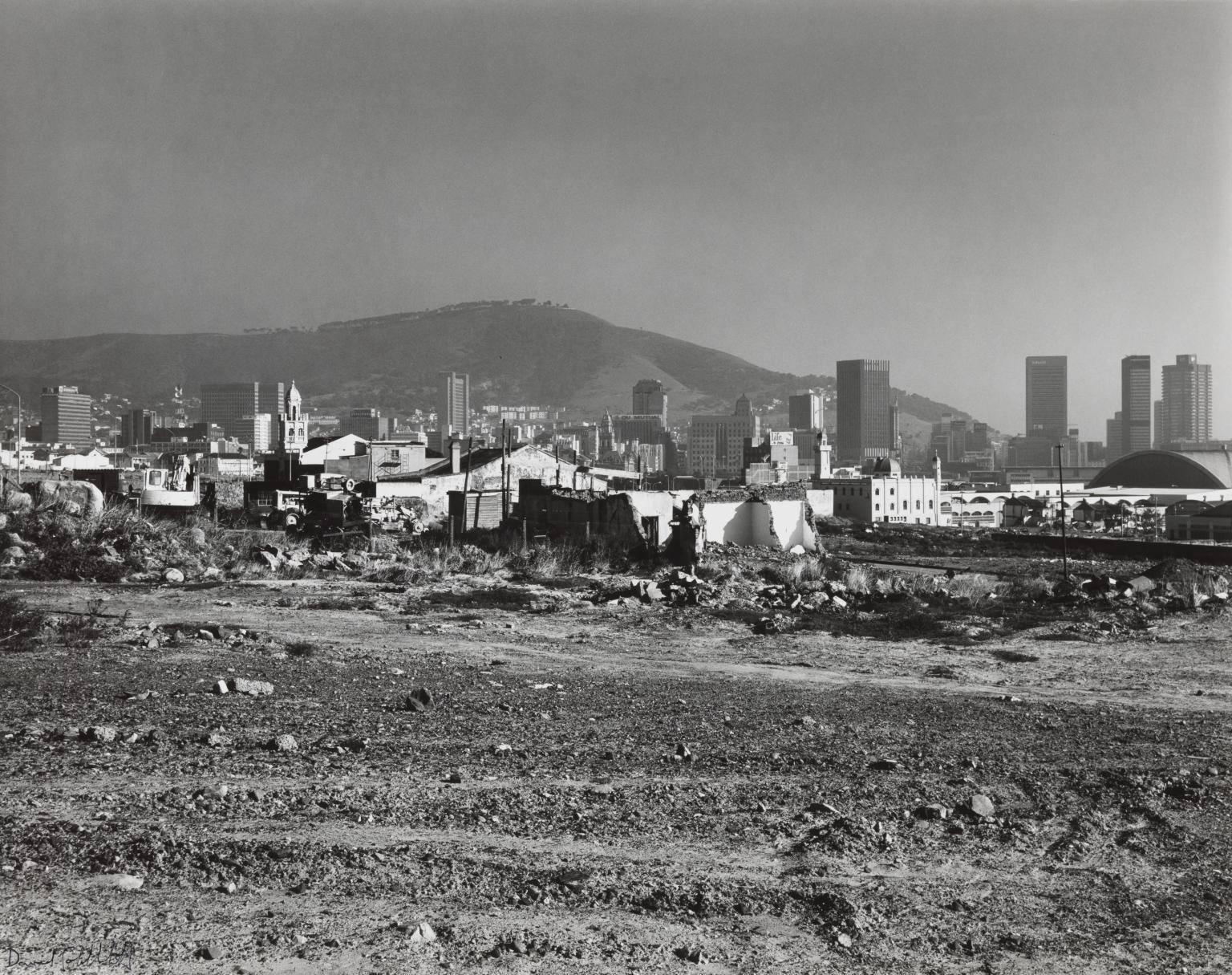
David Goldblatt, The destruction of District Six under the Group Areas Act. Cape Town, Cape. 5 May 1982 1982
7/30
artworks in Journeys through the Tate Collection
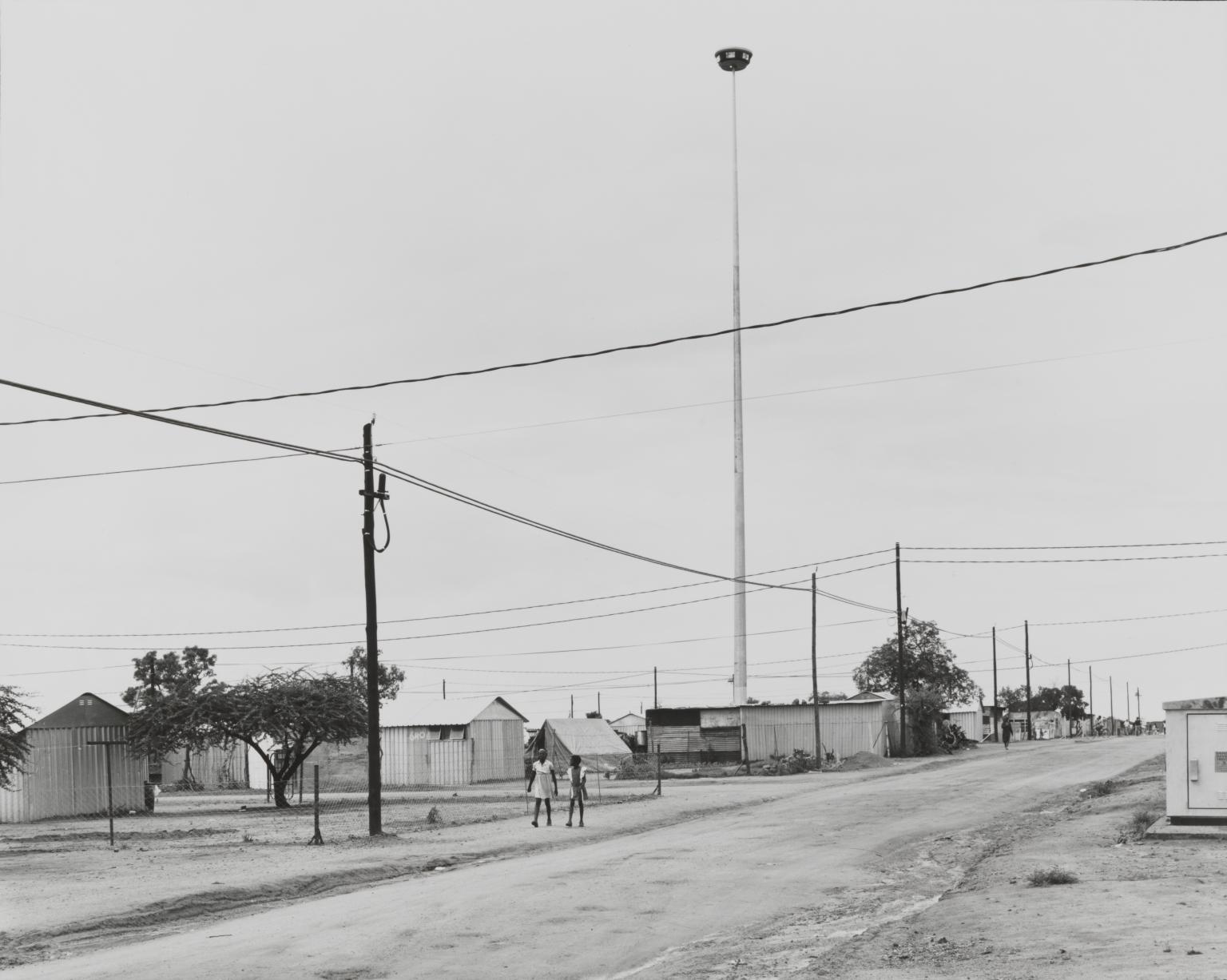
David Goldblatt, The place to which the government wanted the people of Oukasie to move. Letlhabile Removal Camp, Transvaal. 30 November 1986 1986
8/30
artworks in Journeys through the Tate Collection
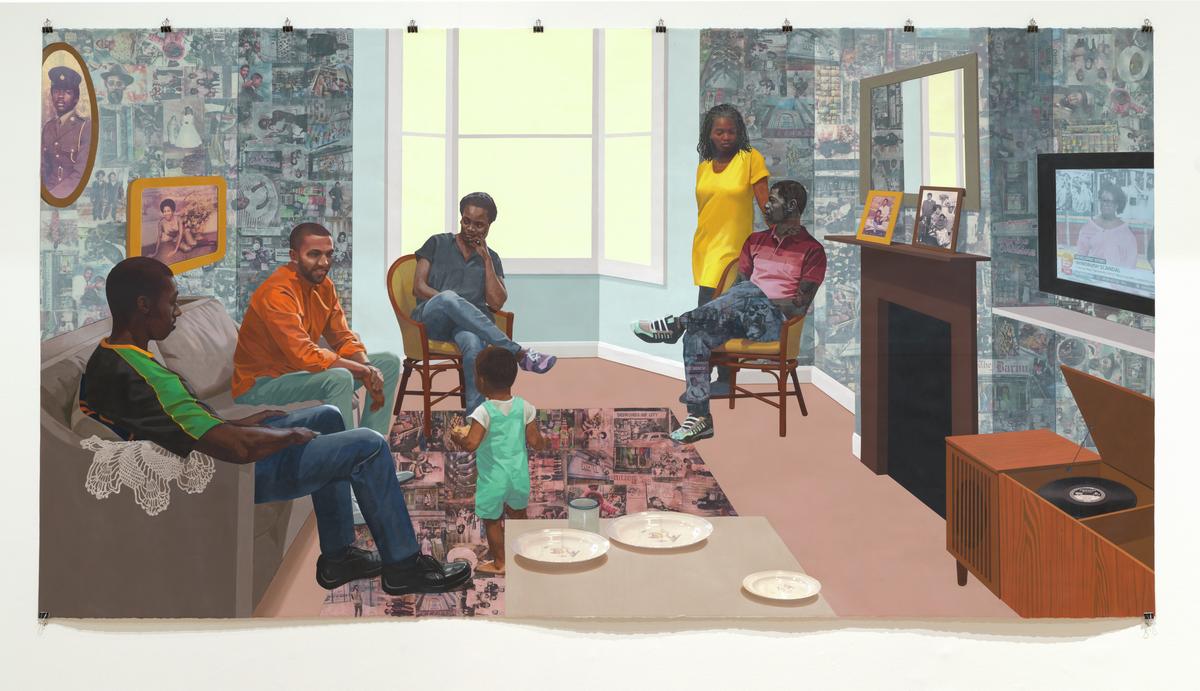
Njideka Akunyili Crosby, Remain, Thriving 2018
Made for Brixton Underground station, this scene imagines a gathering of the grandchildren of the ‘Windrush generation’ who moved to Britain following the 1948 British Nationality Act. The patterned walls, radiogram and hanging pictures are reminiscent of ‘front rooms’ they may associate with their grandparents. The wall imagery derives from photography in Brixton’s Black Cultural Archives, Including portraits of Dub poet Linton Kwesi Johnson and activist Olive Morris. The scene is not simply celebratory: 2018 news of the Windrush scandal’s deportation of commonwealth citizens plays on television.
Gallery label, January 2022
9/30
artworks in Journeys through the Tate Collection

Hew Locke, Armada 2017–2019
Armada 2019 is an installation made up of forty-five boats of varying sizes made by the artist between 2017 and 2019. The flotilla, which is suspended from the ceiling around shoulder height, includes boats from different periods and places – miniature cargo ships and fishing boats sit alongside caravels and galleons. Locke has described them as votive boats, based on models he had seen in churches and cathedrals in continental Europe, offered by worshippers to give thanks for survival at sea (in Buck 2019, accessed 29 November 2019). Each boat is made from and decorated with a variety of materials. Some of them feature plastic toys, nets and decorations which are mass produced and widely available very cheaply; others incorporate jewels, charms, military badges and replica medals from conflicts involving former colonies. Some are adorned with brass cut-outs featuring Portuguese mercenaries as depicted by sixteenth-century Benin sculptors, along with images of contemporary soldiers. Coins from places like the Caribbean, Gambia and Syria call to mind international trade and the movement of goods, as well as the movement of people and the current global refugee crisis.
10/30
artworks in Journeys through the Tate Collection
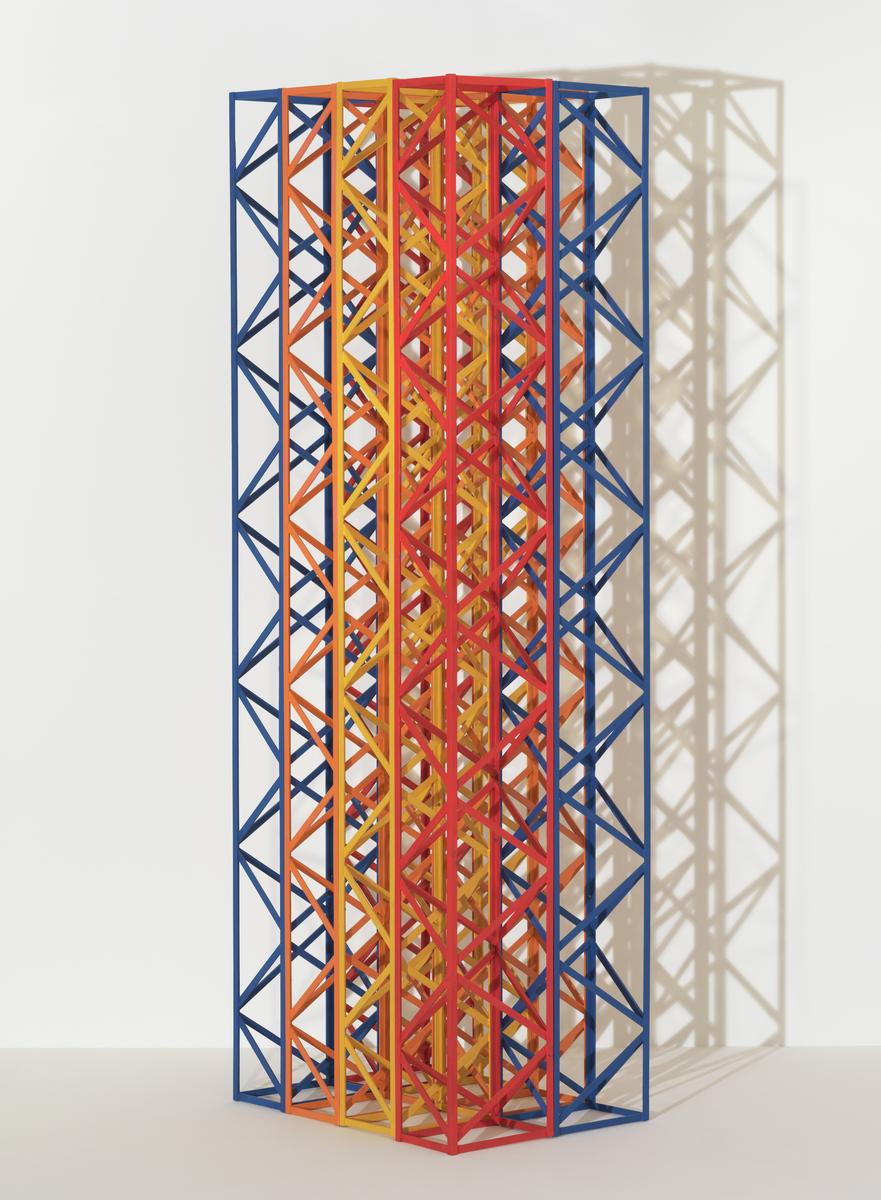
Rasheed Araeen, Rang Baranga 1969
After relocating to London from Karachi, Pakistan, in 1964, Araeen was struck by the work of the British sculptor Anthony Caro and decided to devote himself full-time to sculpture. Rather than following Caro’s example of a compositionally driven practice, Araeen decided that symmetrical configuration should form the basis of a new kind of sculpture. Formally Rang Baranga resembles the structures of Sol Lewitt’s open minimalist sculptures, but unlike the American artist’s, Araeen’s forms incorporate diagonal and orthogonal elements which refer in part to Islamic art but more importantly point to his training and practice as an engineer.
Gallery label, September 2016
11/30
artworks in Journeys through the Tate Collection
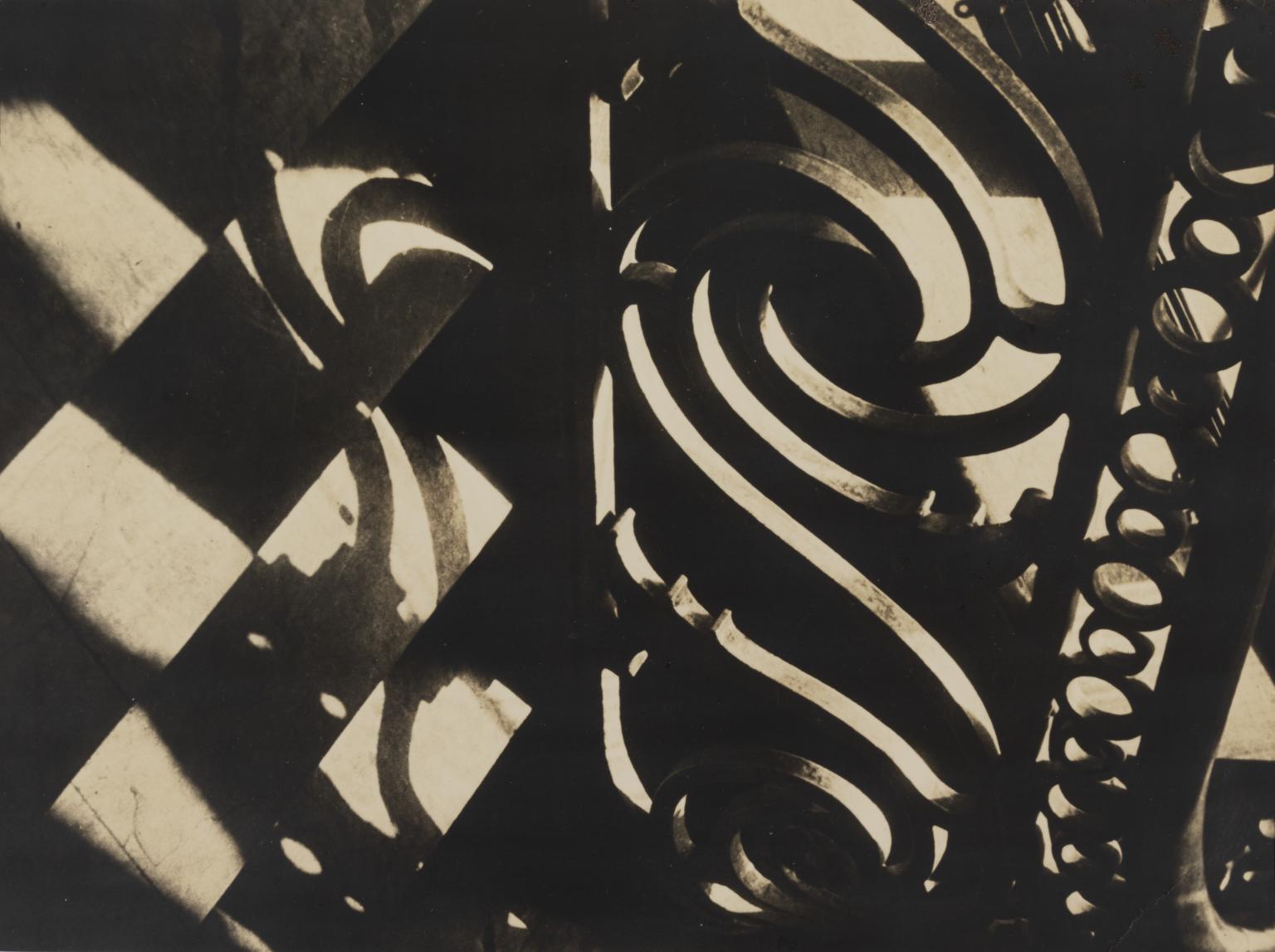
Shikanosuke Yagaki, Banister Detail 1930–9
Banister Detail 1930–9 is a photograph taken by the Japanese modernist photographer Shikanosuke Yagaki. It depicts a close-up view of a section of staircase and an iron banister. The uneven patterns formed by the oblique angle of the banister demonstrate Yagaki’s interest in the formal potential of photography as a way of exploring composition through light and shadow.
12/30
artworks in Journeys through the Tate Collection
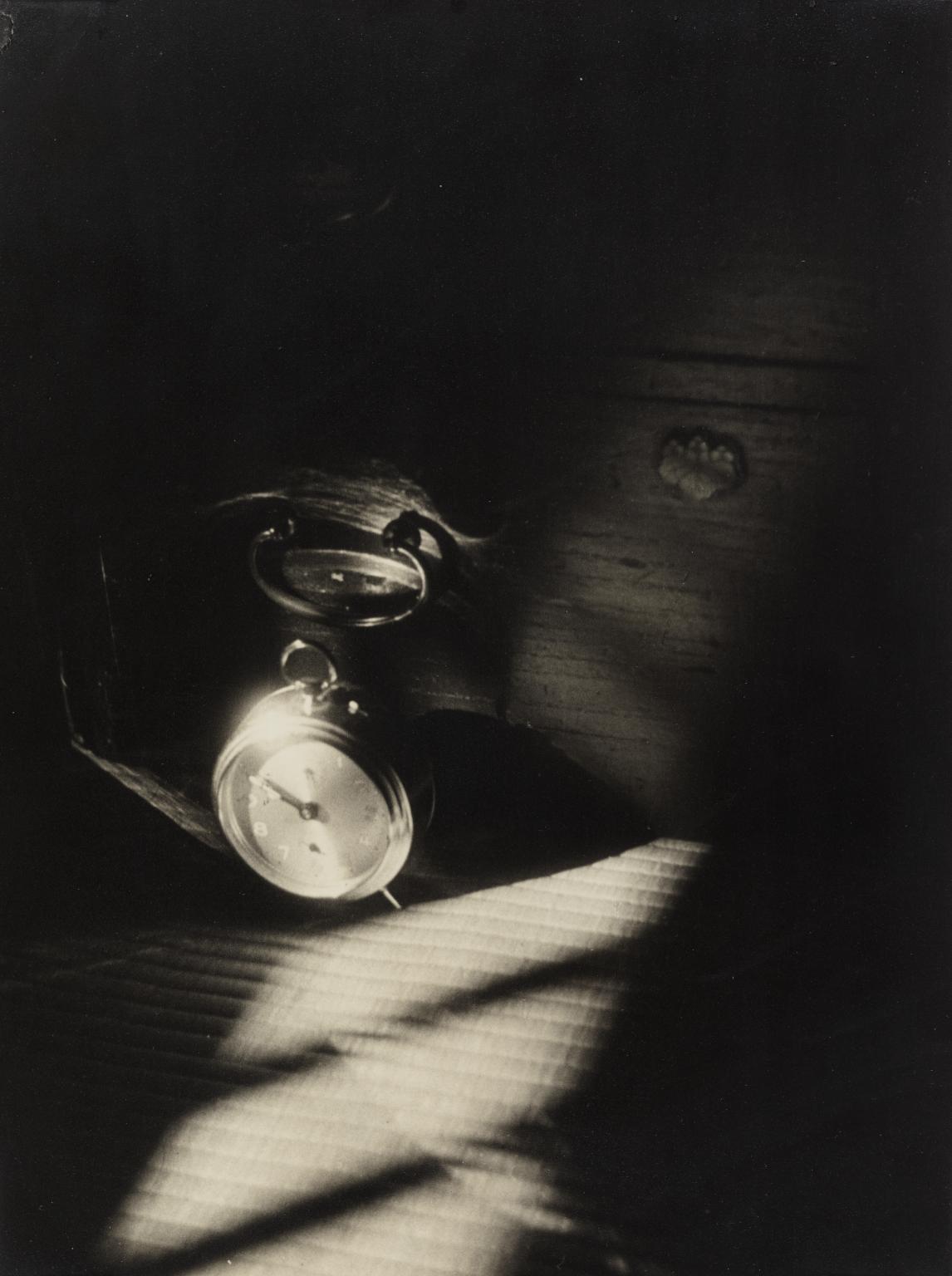
Shikanosuke Yagaki, Untitled (Clock) 1930–9
Shikanosuke Yagaki was an active member of many of the amateur photography clubs flourishing in Japan in the 1930s, including the Sanwa Bank Photo Club, the Karashishi-kai Photo Group, and the Kyoto Leica Club and his work was widely exhibited. Despite a lack of professional training, Yagaki developed a sophisticated style which combined the influence of European modernism with typical Japanese subjects. His work shows a great understanding of the camera’s potential, playing with movement, perspective, light and shadow.
Gallery label, June 2011
13/30
artworks in Journeys through the Tate Collection

Iwao Yamawaki, Zuyev Workers’ Club Moscow 1931
Born in Fujita, Nagasaki, Iwao Yamawaki studied architecture at the Tokyo School of Arts and after graduating worked as an architect in a construction company. During this time, he took pictures with his 35mm camera to support and document his architectural studies. In 1931 he travelled to Germany to study at the Bauhaus in Dessau and became heavily influenced by László Moholy-Nagy’s idea that photography could open up new ways of seeing the world beyond those available to the human eye. Yamawaki travelled widely in Europe and the Soviet Union, documenting modernist architecture and design, as well as capturing student life at the Bauhaus.
Gallery label, November 2015
14/30
artworks in Journeys through the Tate Collection

Gauri Gill, Rajesh Vangad, The Eye in the Sky 2014–16
These photographs show evidence of sea pollution in a small mangrove forest in Port Dickson, Malaysia, Gill’s hometown. Colourful plastic bags and other rubbish have washed up with the tides, getting stuck in branches and roots. In the black and white photographs, it can be hard to distinguish the waste among the plants. The first photo shows large cargo ships in the distance. This suggests the activities of Port Dickson’s commercial harbour are the source of the detritus. More widely, the series raises questions about the consequences of globalisation on the environment.
Gallery label, June 2021
15/30
artworks in Journeys through the Tate Collection
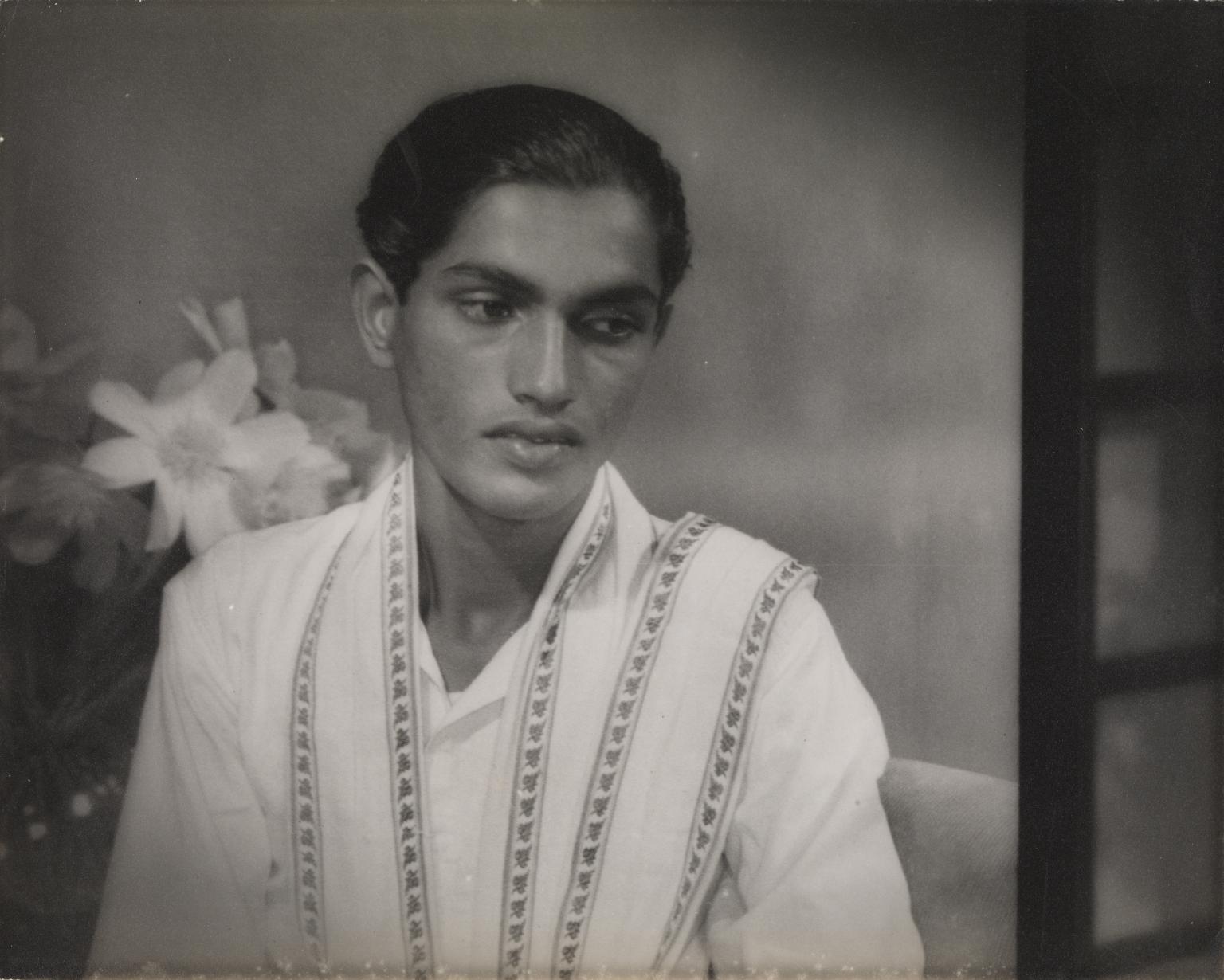
Lionel Wendt, [title not known] c.1933–6
16/30
artworks in Journeys through the Tate Collection
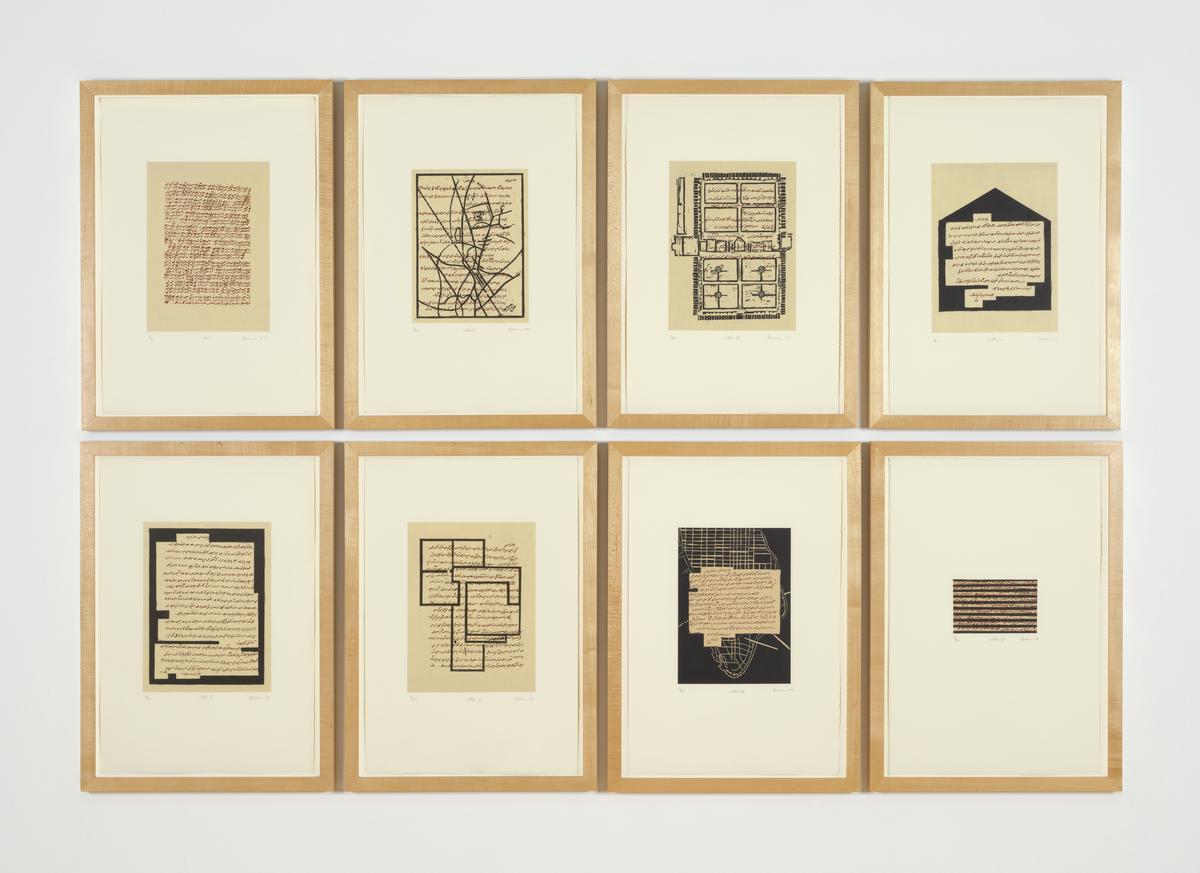
Zarina Hashmi, Letters from Home 2004
This series of prints is based on letters written by the artist’s sister who lived in Pakistan. Lines of handwritten prose in Urdu are overlaid and obscured with maps and blueprints of distant homes and places. The letters mark significant moments – the death of a parent, for instance – and some of the prints bear impressions of places relevant to their estranged lives. Hashmi maps and conveys the experience of loss and dispossession due to political conflict. The break with the Urdu literary culture of undivided India is poignant for the artist who was born in Aligarh, a university town and centre of learning.
Gallery label, April 2013
17/30
artworks in Journeys through the Tate Collection
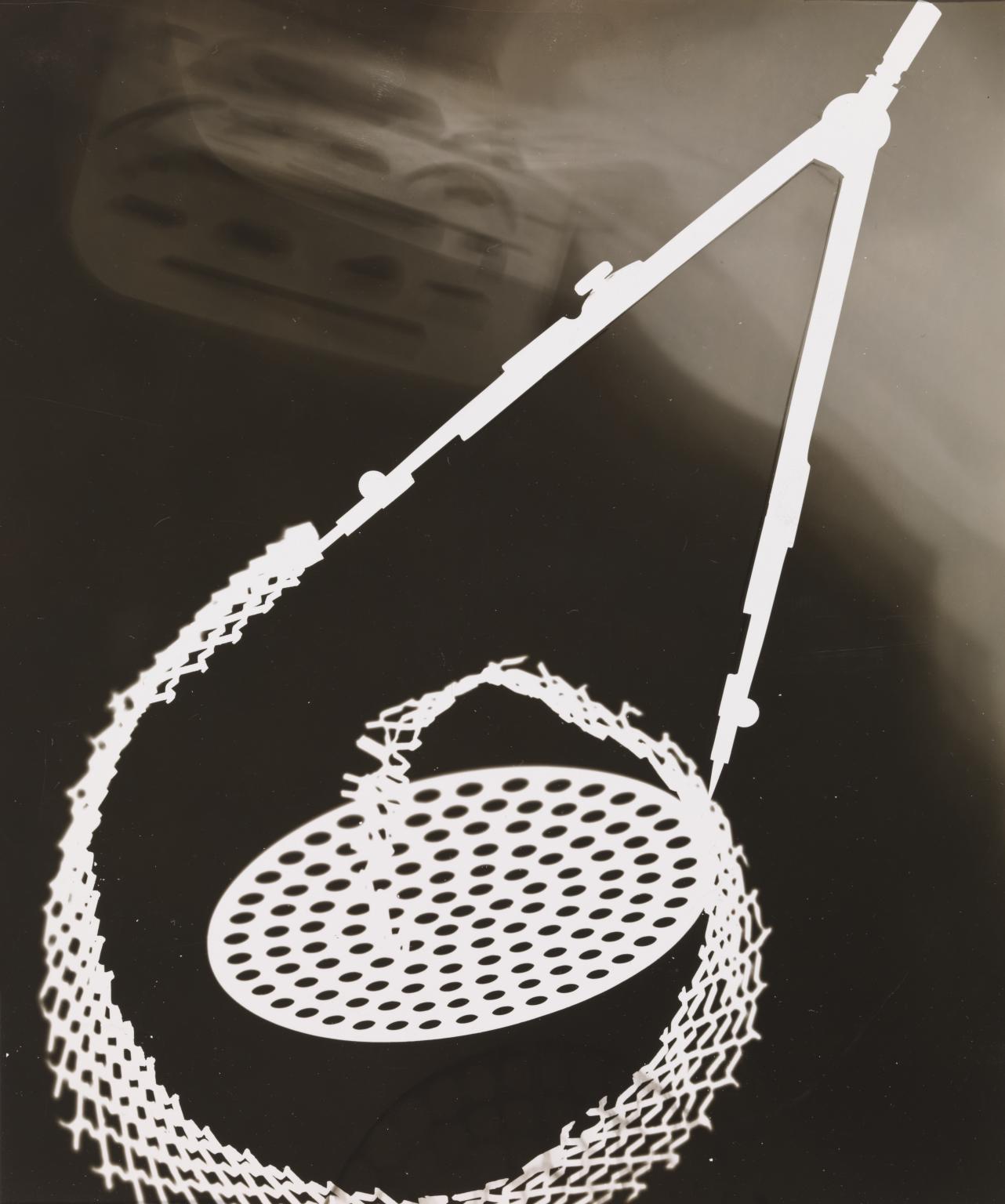
György Kepes, Compass and Strainer Photogram n.d
This is one of a large group of photograms and studies in modernist photography in Tate’s collection by the Hungarian-born photographer, painter, designer, teacher and writer, Gyorgy Kepes (see Tate P80532–P80568, T13973–T13975). They date from 1938 to the early 1940s and were made in the United States, where Kepes had emigrated in 1937. Kepes made his earliest photograms in Budapest, taking nature as his starting point, directly recording the process without a camera onto photosensitized surfaces. In the late 1920s Kepes joined the Berlin studio of the Hungarian artist and modernist photographer László Moholy-Nagy (1895–1946). Moholy-Nagy had been a teacher at the Bauhaus School in Germany and was one of the principals in promoting the values of the Bauhaus movement, as well as a pioneer who experimented with a multitude of materials and techniques. Kepes was introduced to the ‘new vision’ provided by the possibilities of modern art techniques while collaborating alongside Moholy-Nagy. He began to experiment with photograms himself – photographic prints made in the darkroom by placing objects directly onto light sensitive paper and exposing the paper to light. Later, he made prints he called ‘photo-drawings’, in which he applied paint to a glass plate that he then used as though it were a negative. Only a few of Kepes’s works from this earlier period survived the artist’s many moves in the 1930s and the Second World War.
18/30
artworks in Journeys through the Tate Collection
Sorry, no image available
Paulo Nazareth, Cinema Africa 2012–2013
19/30
artworks in Journeys through the Tate Collection

Fahrelnissa Zeid, Untitled c.1950s
Fahrelnissa Zeid used swirling, crossing lines to paint this abstract artwork. After drawing the lines in pencil, she filled in the shapes made between them with black, green, blue and pink. The result is a complex, kaleidoscopic effect. Zeid made the painting when she was living in London in the 1950s. In 1949 she had taken her first transatlantic flight and was captivated by the abstracted perspective of aerial views. She later translated their scale and feeling into the whirling shapes that appear in this painting. A divisionist effect is achieved, whereby individual patches of colour are built up to create an overall composition.
Gallery label, November 2021
20/30
artworks in Journeys through the Tate Collection
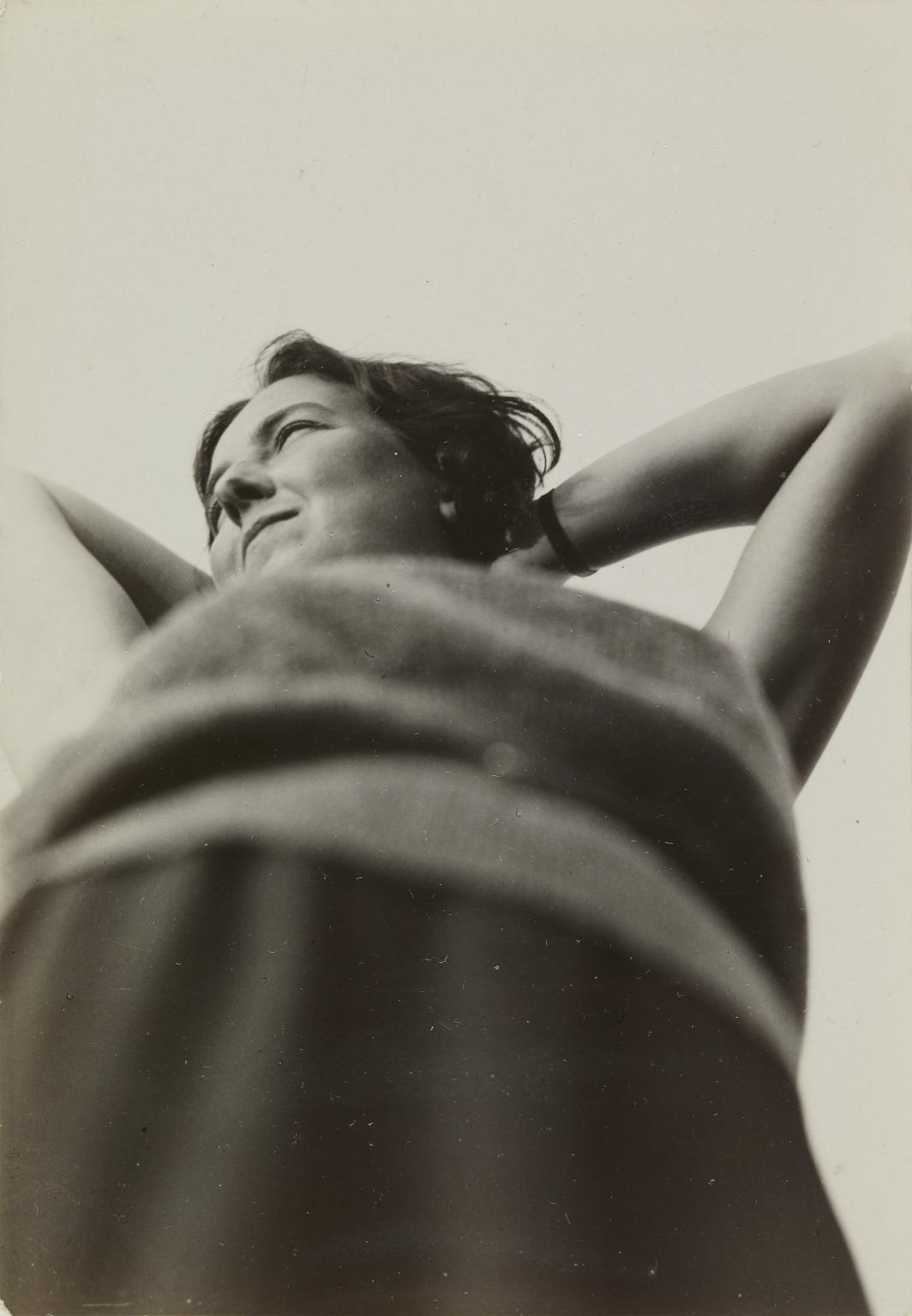
Iwao Yamawaki, Bauhaus Student 1930–2
Born in Fujita, Nagasaki, Iwao Yamawaki studied architecture at the Tokyo School of Arts and after graduating worked as an architect in a construction company. During this time, he took pictures with his 35mm camera to support and document his architectural studies. In 1931 he travelled to Germany to study at the Bauhaus in Dessau and became heavily influenced by László Moholy-Nagy’s idea that photography could open up new ways of seeing the world beyond those available to the human eye. Yamawaki travelled widely in Europe and the Soviet Union, documenting modernist architecture and design, as well as capturing student life at the Bauhaus.
Gallery label, November 2015
21/30
artworks in Journeys through the Tate Collection

Shikanosuke Yagaki, Stairs 1930–9
Shikanosuke Yagaki was an active member of many of the amateur photography clubs flourishing in Japan in the 1930s, including the Sanwa Bank Photo Club, the Karashishi-kai Photo Group, and the Kyoto Leica Club and his work was widely exhibited. Despite a lack of professional training, Yagaki developed a sophisticated style which combined the influence of European modernism with typical Japanese subjects. His work shows a great understanding of the camera’s potential, playing with movement, perspective, light and shadow.
Gallery label, June 2011
22/30
artworks in Journeys through the Tate Collection
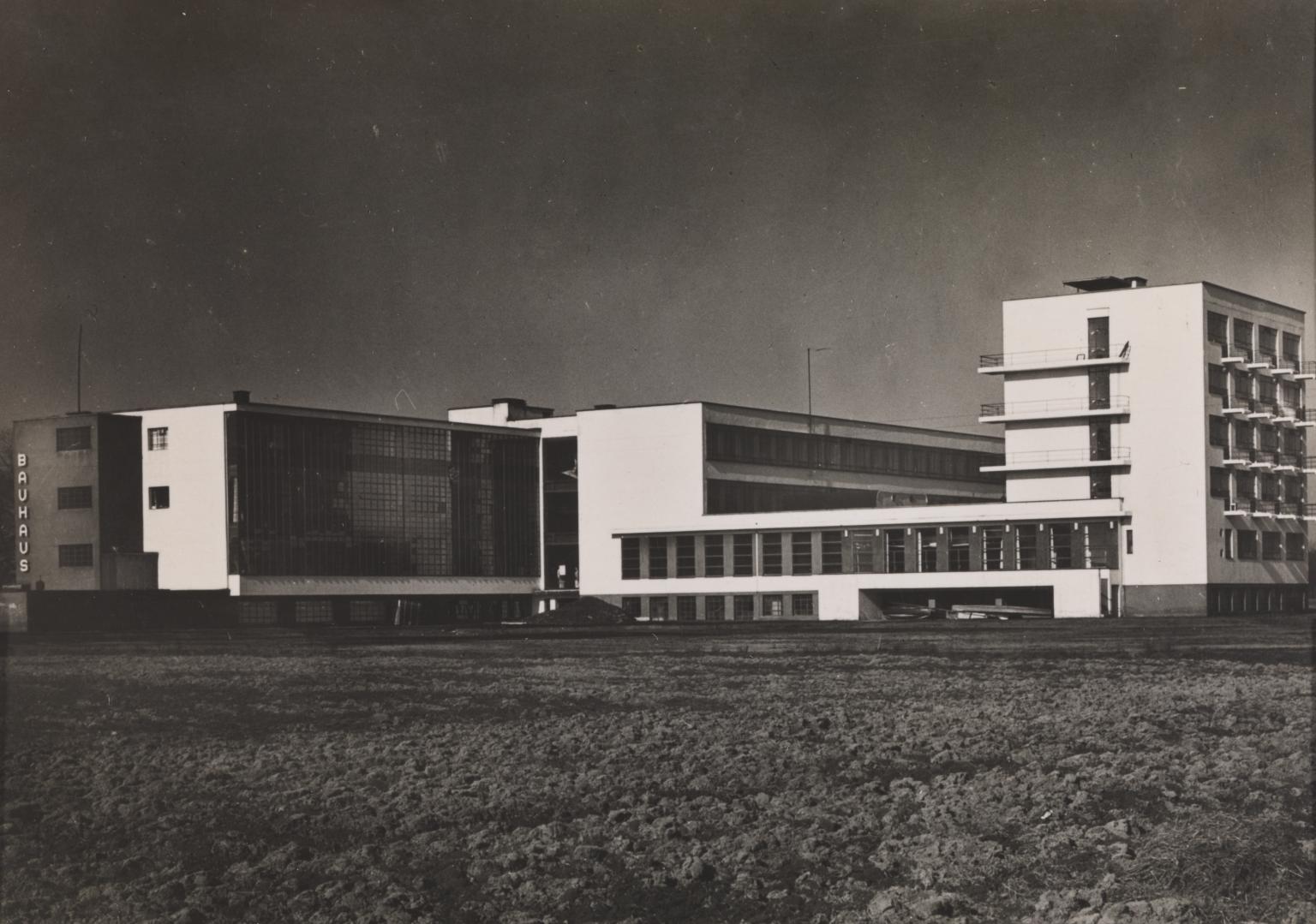
Lucia Moholy, Bauhaus Building, Dessau 1925–6
Lucia Moholy moved to Dessau to accompany her husband László Moholy-Nagy (1895–1946) when he began teaching at the Bauhaus school of art, architecture and design. There she produced many iconic photographs documenting the architecture of the Bauhaus buildings in the mid-1920s.
Gallery label, November 2015
23/30
artworks in Journeys through the Tate Collection
Sorry, no image available
Paulo Nazareth, Cinema Brasil 2012–2013
24/30
artworks in Journeys through the Tate Collection
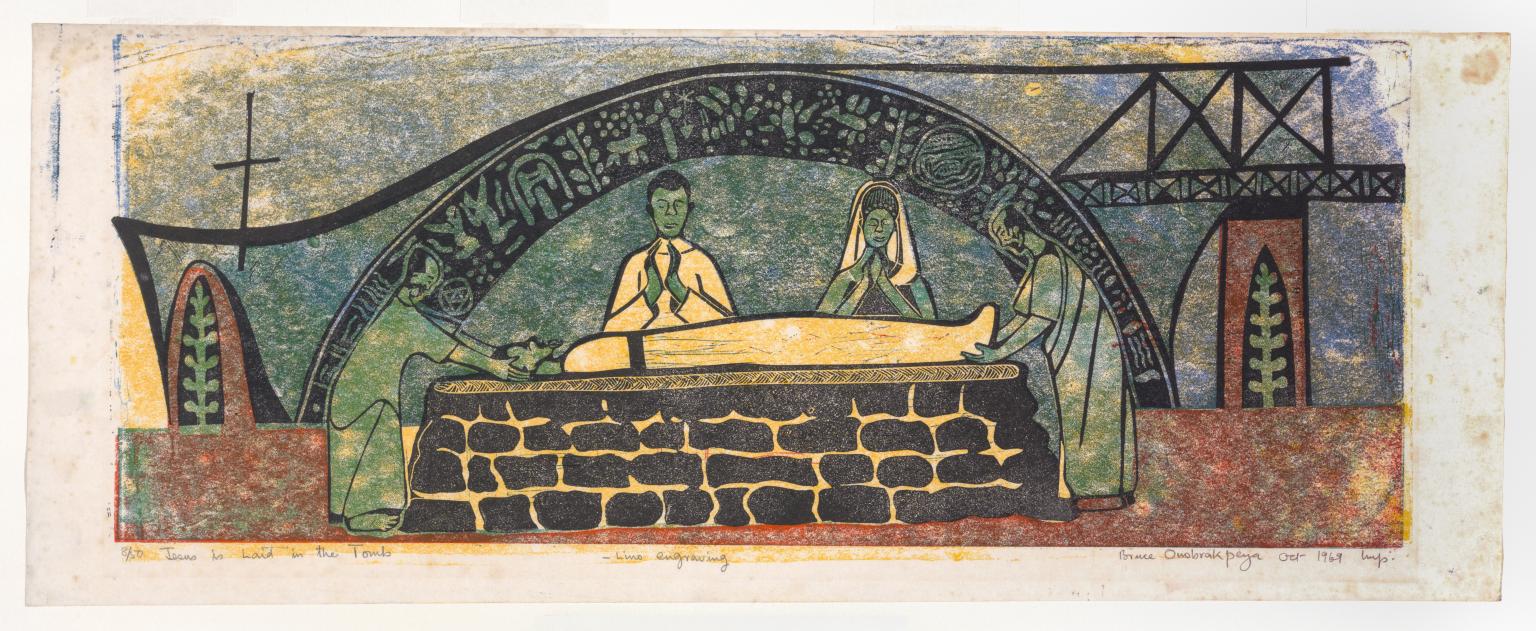
Bruce Onobrakpeya, Jesus is laid in the tomb 1969
This is one in a series by Nigerian artist Bruce Onobrakpeya comprising fourteen linocut prints on paper in an elongated landscape format. The subject is a biblical one, with each of the prints depicting a different moment from Jesus’ last days on Earth as a man, beginning with his condemnation by Pontius Pilate and ending with his crucifixion and laying in the tomb. The episodes portrayed – known in Christian theology as The Stations of the Cross – are precisely detailed and dramatised in Onobrakpeya’s prints, but have been placed within an African setting. The apostles wear vividly patterned local Adire prints and those restraining Jesus appear to be wearing colonial-era police uniform. The overall palette of the series is blue and green, with hints of yellow and highlights in orange. Geometric shapes abound, recalling patterns found on traditional Nigerian textiles and architecture. While these forms structure the compositions, they also extend onto the crosses that feature prominently in many of the images. The prints are individually titled as follows: Jesus is Condemned to Death, Jesus Takes his Cross, Jesus Falls the First Time, Jesus Meets his Mother, Simon of Cyrene Helps Jesus, Veronica Wipes Jesus’ Face, Jesus Falls the Second Time, Jesus and the Women of Jerusalem, Jesus Falls the Third Time, Jesus’ Clothes are Torn Off, Jesus is Nailed to the Cross, Jesus Dies on the Cross, Jesus is Taken from the Cross and Jesus is Laid in the Tomb. Thirteen of the prints are number eight in an edition of fifty. Jesus Falls the First Time is number eight in an edition of forty-eight. Complete sets of the prints are rare; although they can be shown individually, they are ideally shown all together as they were in the inaugural exhibition at Tate Modern, London in 2001, Century City: Art and Culture in the Modern Metropolis.
25/30
artworks in Journeys through the Tate Collection
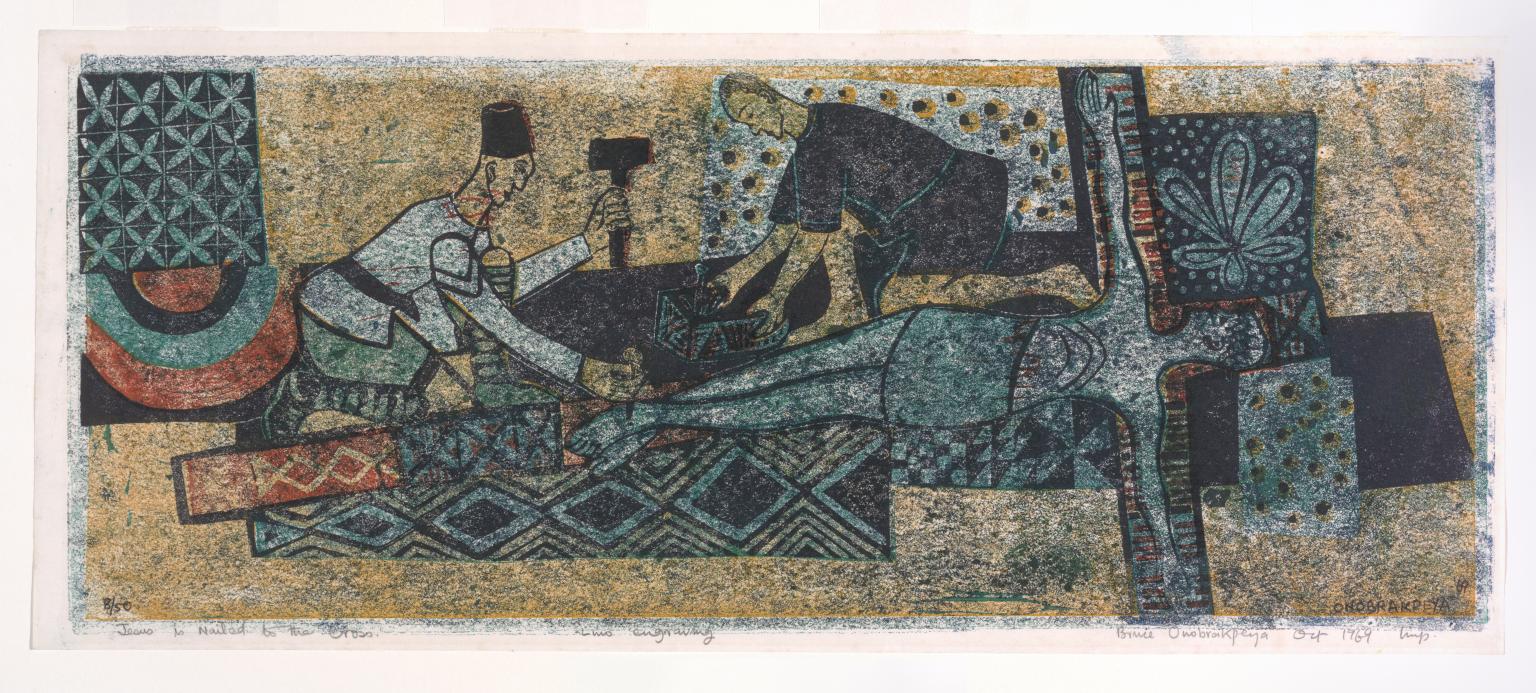
Bruce Onobrakpeya, Jesus is nailed to the cross 1969
This is one in a series by Nigerian artist Bruce Onobrakpeya comprising fourteen linocut prints on paper in an elongated landscape format. The subject is a biblical one, with each of the prints depicting a different moment from Jesus’ last days on Earth as a man, beginning with his condemnation by Pontius Pilate and ending with his crucifixion and laying in the tomb. The episodes portrayed – known in Christian theology as The Stations of the Cross – are precisely detailed and dramatised in Onobrakpeya’s prints, but have been placed within an African setting. The apostles wear vividly patterned local Adire prints and those restraining Jesus appear to be wearing colonial-era police uniform. The overall palette of the series is blue and green, with hints of yellow and highlights in orange. Geometric shapes abound, recalling patterns found on traditional Nigerian textiles and architecture. While these forms structure the compositions, they also extend onto the crosses that feature prominently in many of the images. The prints are individually titled as follows: Jesus is Condemned to Death, Jesus Takes his Cross, Jesus Falls the First Time, Jesus Meets his Mother, Simon of Cyrene Helps Jesus, Veronica Wipes Jesus’ Face, Jesus Falls the Second Time, Jesus and the Women of Jerusalem, Jesus Falls the Third Time, Jesus’ Clothes are Torn Off, Jesus is Nailed to the Cross, Jesus Dies on the Cross, Jesus is Taken from the Cross and Jesus is Laid in the Tomb. Thirteen of the prints are number eight in an edition of fifty. Jesus Falls the First Time is number eight in an edition of forty-eight. Complete sets of the prints are rare; although they can be shown individually, they are ideally shown all together as they were in the inaugural exhibition at Tate Modern, London in 2001, Century City: Art and Culture in the Modern Metropolis.
26/30
artworks in Journeys through the Tate Collection
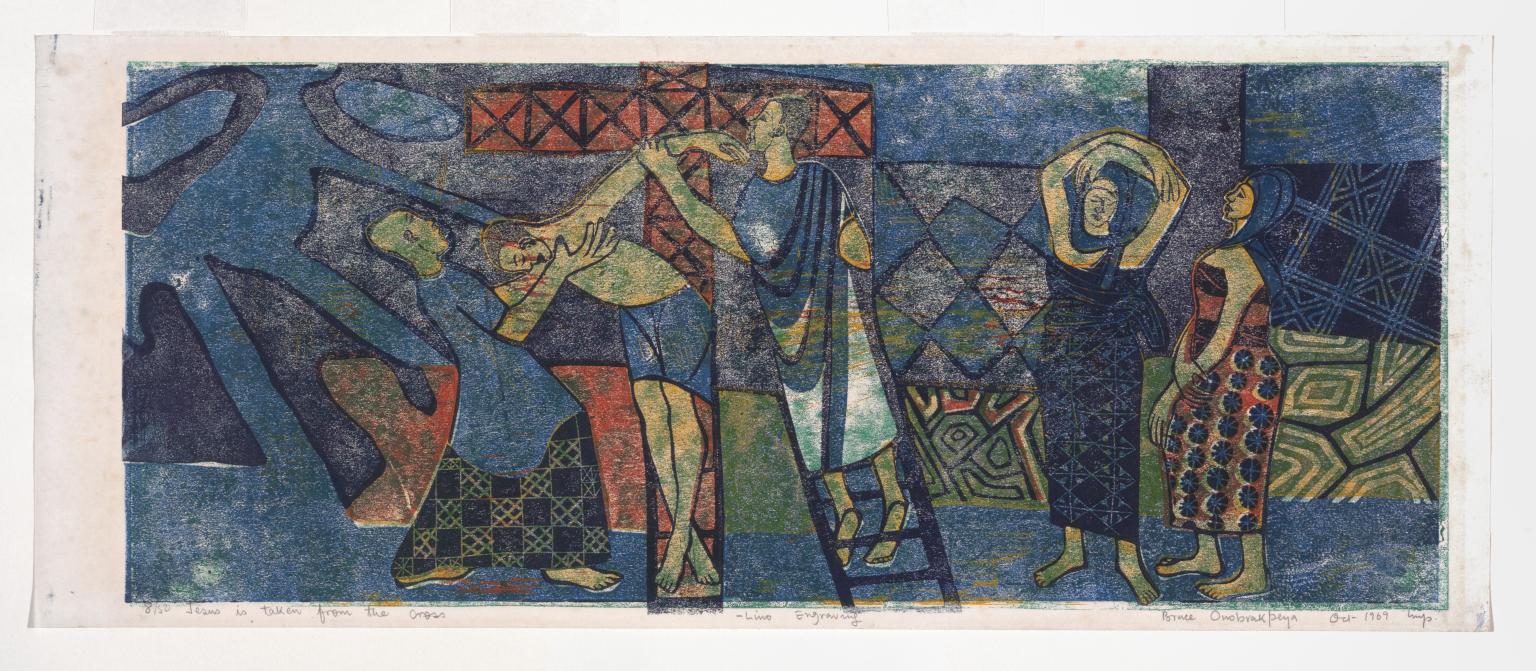
Bruce Onobrakpeya, Jesus is taken from the cross 1969
This is one in a series by Nigerian artist Bruce Onobrakpeya comprising fourteen linocut prints on paper in an elongated landscape format. The subject is a biblical one, with each of the prints depicting a different moment from Jesus’ last days on Earth as a man, beginning with his condemnation by Pontius Pilate and ending with his crucifixion and laying in the tomb. The episodes portrayed – known in Christian theology as The Stations of the Cross – are precisely detailed and dramatised in Onobrakpeya’s prints, but have been placed within an African setting. The apostles wear vividly patterned local Adire prints and those restraining Jesus appear to be wearing colonial-era police uniform. The overall palette of the series is blue and green, with hints of yellow and highlights in orange. Geometric shapes abound, recalling patterns found on traditional Nigerian textiles and architecture. While these forms structure the compositions, they also extend onto the crosses that feature prominently in many of the images. The prints are individually titled as follows: Jesus is Condemned to Death, Jesus Takes his Cross, Jesus Falls the First Time, Jesus Meets his Mother, Simon of Cyrene Helps Jesus, Veronica Wipes Jesus’ Face, Jesus Falls the Second Time, Jesus and the Women of Jerusalem, Jesus Falls the Third Time, Jesus’ Clothes are Torn Off, Jesus is Nailed to the Cross, Jesus Dies on the Cross, Jesus is Taken from the Cross and Jesus is Laid in the Tomb. Thirteen of the prints are number eight in an edition of fifty. Jesus Falls the First Time is number eight in an edition of forty-eight. Complete sets of the prints are rare; although they can be shown individually, they are ideally shown all together as they were in the inaugural exhibition at Tate Modern, London in 2001, Century City: Art and Culture in the Modern Metropolis.
27/30
artworks in Journeys through the Tate Collection
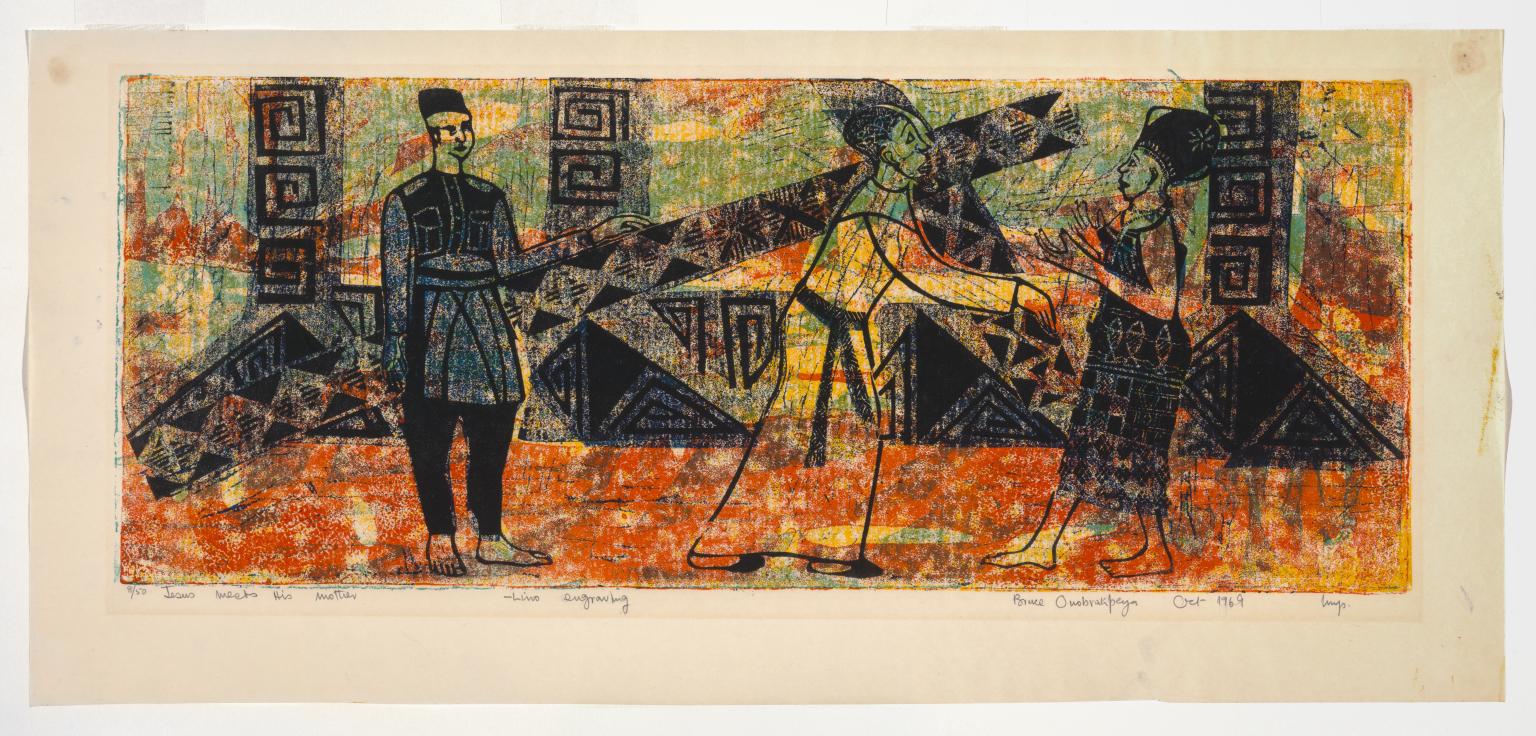
Bruce Onobrakpeya, Jesus meets his mother 1969
This is one in a series by Nigerian artist Bruce Onobrakpeya comprising fourteen linocut prints on paper in an elongated landscape format. The subject is a biblical one, with each of the prints depicting a different moment from Jesus’ last days on Earth as a man, beginning with his condemnation by Pontius Pilate and ending with his crucifixion and laying in the tomb. The episodes portrayed – known in Christian theology as The Stations of the Cross – are precisely detailed and dramatised in Onobrakpeya’s prints, but have been placed within an African setting. The apostles wear vividly patterned local Adire prints and those restraining Jesus appear to be wearing colonial-era police uniform. The overall palette of the series is blue and green, with hints of yellow and highlights in orange. Geometric shapes abound, recalling patterns found on traditional Nigerian textiles and architecture. While these forms structure the compositions, they also extend onto the crosses that feature prominently in many of the images. The prints are individually titled as follows: Jesus is Condemned to Death, Jesus Takes his Cross, Jesus Falls the First Time, Jesus Meets his Mother, Simon of Cyrene Helps Jesus, Veronica Wipes Jesus’ Face, Jesus Falls the Second Time, Jesus and the Women of Jerusalem, Jesus Falls the Third Time, Jesus’ Clothes are Torn Off, Jesus is Nailed to the Cross, Jesus Dies on the Cross, Jesus is Taken from the Cross and Jesus is Laid in the Tomb. Thirteen of the prints are number eight in an edition of fifty. Jesus Falls the First Time is number eight in an edition of forty-eight. Complete sets of the prints are rare; although they can be shown individually, they are ideally shown all together as they were in the inaugural exhibition at Tate Modern, London in 2001, Century City: Art and Culture in the Modern Metropolis.
28/30
artworks in Journeys through the Tate Collection
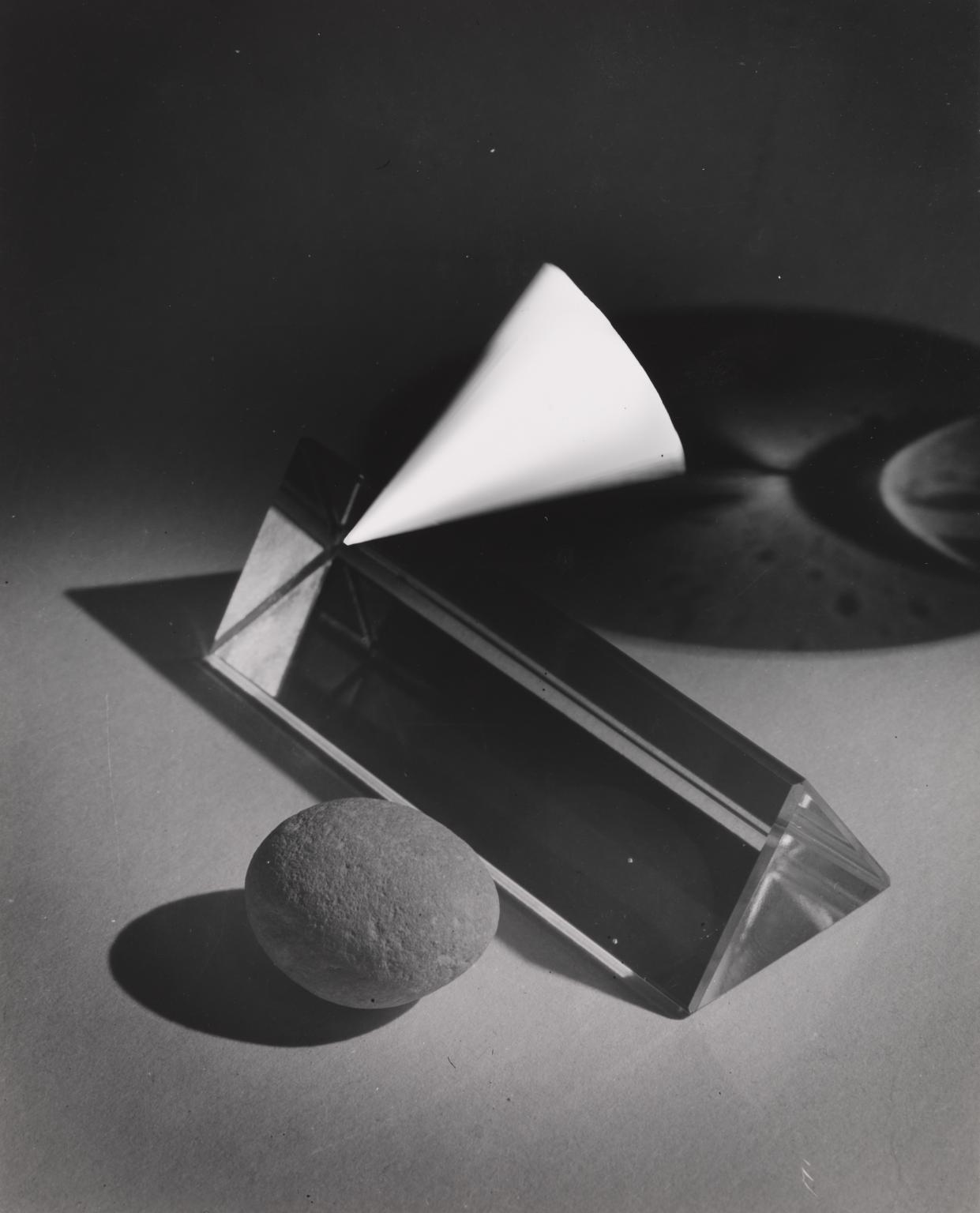
György Kepes, Cone, Prism, Rock c.1939–40
This is one of a large group of photograms and studies in modernist photography in Tate’s collection by the Hungarian-born photographer, painter, designer, teacher and writer, Gyorgy Kepes (see Tate P80532–P80568, T13973–T13975). They date from 1938 to the early 1940s and were made in the United States, where Kepes had emigrated in 1937. Kepes made his earliest photograms in Budapest, taking nature as his starting point, directly recording the process without a camera onto photosensitized surfaces. In the late 1920s Kepes joined the Berlin studio of the Hungarian artist and modernist photographer László Moholy-Nagy (1895–1946). Moholy-Nagy had been a teacher at the Bauhaus School in Germany and was one of the principals in promoting the values of the Bauhaus movement, as well as a pioneer who experimented with a multitude of materials and techniques. Kepes was introduced to the ‘new vision’ provided by the possibilities of modern art techniques while collaborating alongside Moholy-Nagy. He began to experiment with photograms himself – photographic prints made in the darkroom by placing objects directly onto light sensitive paper and exposing the paper to light. Later, he made prints he called ‘photo-drawings’, in which he applied paint to a glass plate that he then used as though it were a negative. Only a few of Kepes’s works from this earlier period survived the artist’s many moves in the 1930s and the Second World War.
29/30
artworks in Journeys through the Tate Collection
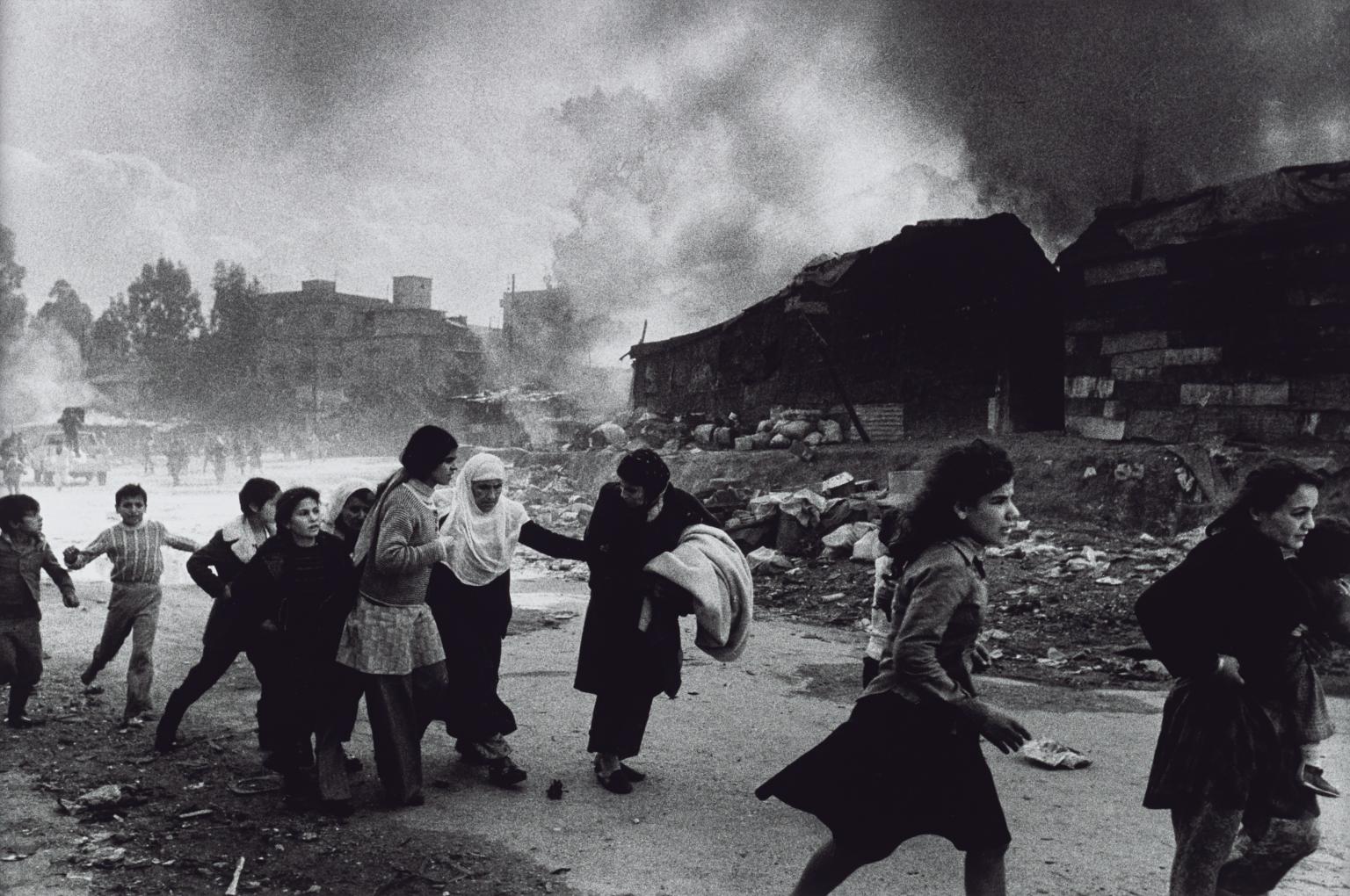
Sir Don McCullin CBE, Palestinian Refugees Fleeing East Beirut Massacre 1976, printed 2013
30/30
artworks in Journeys through the Tate Collection
Art in this room















![P80200: [title not known]](https://media.tate.org.uk/art/images/work/P/P80/P80200_10.jpg)


Sorry, no image available




Sorry, no image available






You've viewed 6/30 artworks
You've viewed 30/30 artworks
